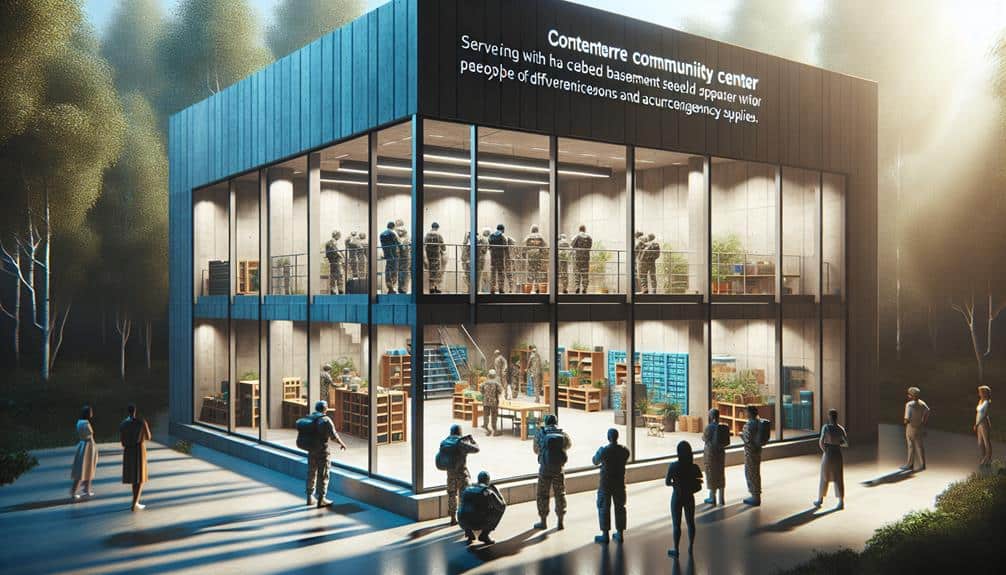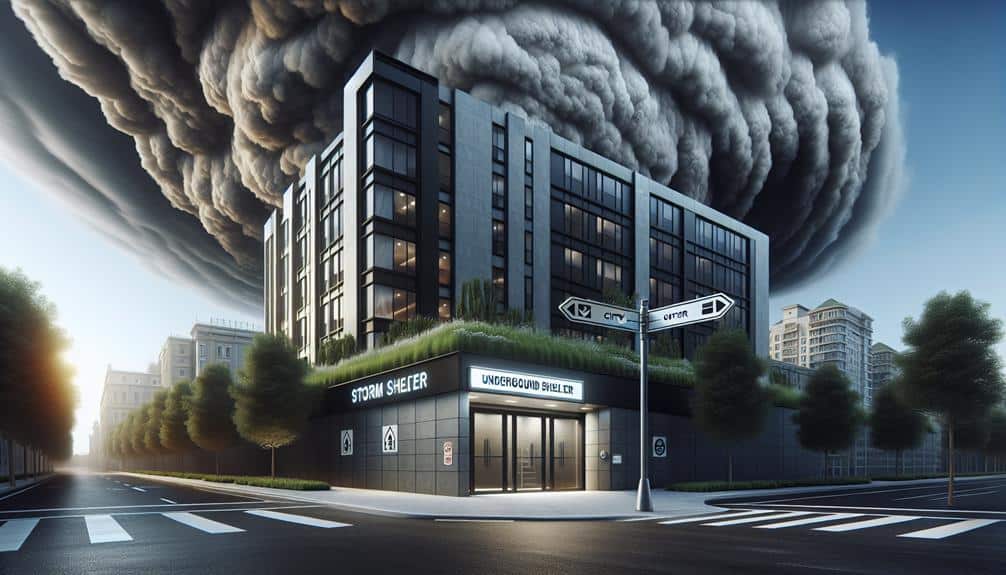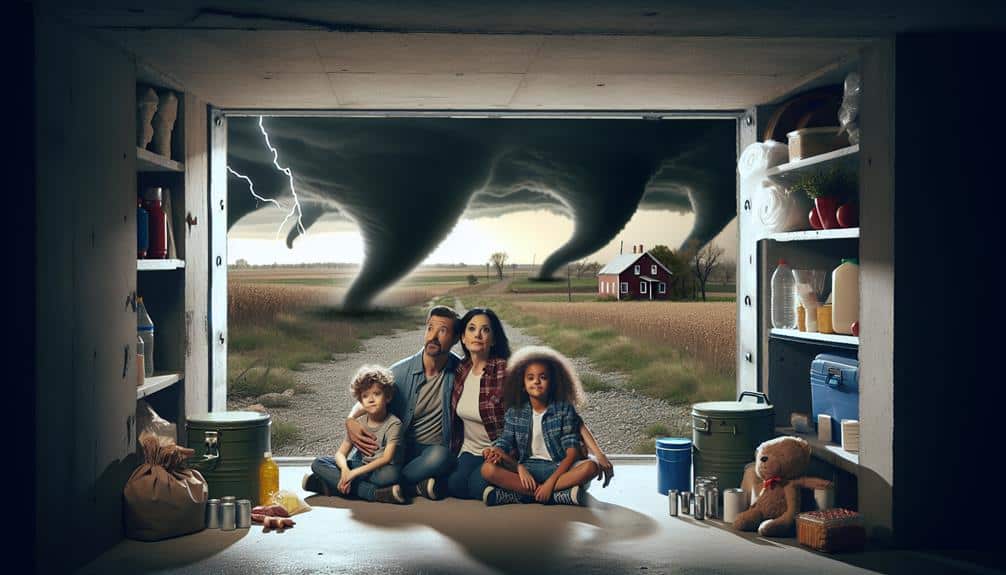We should prioritize storm shelters that offer both structural stability and essential resources. Public libraries and school gymnasiums rank high due to their robust infrastructure and capacity to house large groups. Community centers and fire stations, equipped with emergency supplies, also provide strategic shelter options. Municipal buildings, following strict safety regulations, ensure enhanced protection, while underground parking garages offer reinforced and secure spaces. Finally, churches and places of worship, with their sturdy construction, play a crucial role in emergency preparedness. Each location has distinct advantages, inviting us to explore further to determine the best fit for our needs during severe weather events.
Key Points
- Public libraries and school gymnasiums offer robust infrastructure and ample space for community storm shelters.
- Fire stations provide fortified structures with essential supplies and trained personnel for immediate emergency response.
- Community centers are strategically located with sturdy construction and extensive space for large groups.
- Municipal buildings adhere to strict structural standards and are equipped with emergency supplies and communication tools.
Public Libraries
Public libraries, often equipped with robust infrastructure and ample space, can serve as reliable storm shelters during severe weather events. These facilities are designed to withstand various environmental conditions, making them a safe haven when nature turns hostile. Additionally, libraries are more than just buildings with strong walls; they're community hubs rich in resources and engagement opportunities.
One of the key advantages of using public libraries as storm shelters is the availability of library resources. From emergency kits to communication tools, libraries often stock essential items that can be pivotal during a crisis. They also have access to up-to-date information and weather reports, which can keep us informed and prepared.
Moreover, community engagement is another significant benefit. Libraries are familiar community centers where people feel comfortable and connected. During a storm, this sense of community can provide emotional support and a network of assistance. The staff are usually trained in emergency protocols, adding an extra layer of safety and organization.
School Gymnasiums
Let's consider school gymnasiums, which often offer the structural integrity needed to withstand severe weather conditions.
We must also evaluate their accessibility, ensuring quick and easy entry during emergencies, and their capacity to accommodate large groups safely.
Structural Integrity Assurance
Guaranteeing the structural integrity of school gymnasiums as storm shelters involves a rigorous assessment of their design, materials, and construction standards. We begin by examining whether the gymnasiums meet current building codes, which are essential for securing safety and reliability. These codes dictate the minimum requirements for structural strength, stability, and durability. By adhering to updated codes, we secure that these structures are capable of withstanding severe weather conditions.
Engineering assessments play a pivotal role in this process. We commission qualified engineers to conduct thorough evaluations of the gymnasiums, focusing on key elements such as load-bearing walls, roofing systems, and foundation stability. These assessments help identify any potential weaknesses or areas needing reinforcement. For instance, the engineers might recommend adding steel bracing or upgrading roofing materials to enhance the gymnasium's resilience against high winds and debris.
Furthermore, we analyze the construction materials used in these gymnasiums. High-quality materials like reinforced concrete and steel are preferred due to their superior strength and durability.
Accessibility and Capacity
Having established the structural integrity of school gymnasiums, we must now examine their accessibility and capacity to guarantee they can accommodate a large number of individuals efficiently and safely during storms.
School gymnasiums often offer a prime location due to their central placement within communities, securing shelter availability and proximity for residents. Quick access is critical, especially when storm warnings provide limited time for evacuation.
To analyze the suitability of school gymnasiums further, let's consider:
- Capacity: These spaces are designed to hold large groups, typically accommodating hundreds of students daily. This inherent capacity makes them suitable for emergency shelter purposes.
- Accessibility: With multiple entrances and exits, gymnasiums facilitate smooth crowd movement, essential during urgent evacuations.
While gymnasiums are generally accessible, we must also ensure they remain open and available during emergencies. This involves pre-coordination with school authorities and emergency response teams to guarantee the facility can be quickly and effectively repurposed as a storm shelter.
Community Centers

Community centers often serve as essential storm shelters due to their sturdy construction, ample space, and accessibility to the public. These centers are typically built to withstand severe weather conditions, making them safe havens during storms. Their strategic locations within residential neighborhoods guarantee that they're within walking distance for many residents, providing a convenient and reliable option when time is of the essence.
In addition to their structural integrity, community centers offer extensive space to accommodate large groups of people. This is particularly beneficial in densely populated areas, where individual homes may not provide adequate protection. Unlike shopping malls, which can be chaotic and lack the necessary provisions during a storm, community centers are equipped with emergency supplies and often have protocols in place to ensure everyone's safety.
Furthermore, the accessibility of community centers can't be overstated. They're public facilities, meaning they're open to everyone, regardless of socio-economic status. This inclusivity ensures that all members of the community have a safe place to go during a storm.
Fire Stations
Fire stations, much like community centers, are strategically designed and fortified to serve as dependable storm shelters, providing a secure refuge for residents during severe weather events. They're constructed to withstand high winds and other harsh conditions, making them an exceptional choice for shelter.
Fire station safety is paramount, and these facilities often include:
- Fortified structures: Built to strict safety codes, fire stations are designed to withstand extreme weather, offering a sturdy shield against natural disasters.
- Emergency readiness: Equipped with essential supplies and communication tools, fire stations can support residents during prolonged emergencies.
When considering the use of fire stations as storm shelters, we must also acknowledge their dual role in community safety. Unlike library emergency shelters, which may be repurposed during crises, fire stations are always operational and staffed with trained personnel ready to respond to emergencies. This dual functionality guarantees not only a safe haven but also immediate access to emergency services.
Municipal Buildings

Let's examine why municipal buildings rank high as storm shelters.
These structures adhere to rigorous structural integrity standards, ensuring they can withstand severe weather conditions.
Additionally, their accessibility and safety features, along with substantial capacity and resources, make them reliable options during emergencies.
Structural Integrity Standards
When evaluating storm shelter locations within municipal buildings, we must thoroughly assess their structural integrity standards to guarantee they can withstand severe weather conditions. It's essential to make certain that these shelters comply with the latest building codes and safety regulations. By doing so, we can reduce risks and enhance the safety of all occupants during emergencies.
Structural integrity standards encompass several essential elements:
- Building codes compliance: Municipal shelters must meet strict local and national building codes. These codes are designed to ensure the structure can endure extreme weather events, such as tornadoes, hurricanes, and severe storms.
- Safety regulations adherence: Shelters should be evaluated to confirm they follow established safety regulations. This includes the construction materials used, the design of the shelter, and its overall durability.
Accessibility and Safety
Securing storm shelters in municipal buildings to be both accessible and safe is crucial for safeguarding all community members during severe weather events. When selecting locations, we must consider proximity to densely populated areas and ease of access for individuals with disabilities. Prioritizing central areas ensures that everyone can reach safety quickly, especially those who may not have personal transportation.
Emergency protocols need to be clearly defined and communicated. Municipal buildings should have well-marked signs directing people to the nearest shelter. Regular drills can reinforce these protocols, making sure that everyone knows exactly what to do when a storm hits. We can't afford any confusion in these high-stress scenarios.
Safety measures are paramount. We need to ensure that shelters are equipped with essential supplies such as water, first aid kits, and basic necessities. Structural reinforcements and regular inspections can guarantee that these buildings withstand severe weather.
Public awareness campaigns are crucial for informing the community about the locations and safety features of these shelters. By disseminating this information through various channels, we can make sure that everyone knows where to go and what to expect, giving them the freedom to act swiftly and confidently when it matters most.
Capacity and Resources
Evaluating the capacity and resources of municipal buildings designated as storm shelters is important for guaranteeing they can effectively accommodate and support the community during severe weather conditions.
First, we need to assess the shelter capacity. How many people can each building house safely? It's essential to avoid overcrowding, which can lead to additional hazards and stress during an emergency.
Next, let's focus on resource allocation. Municipal buildings should be well-stocked with necessary supplies such as food, water, medical kits, and sanitation facilities. Properly allocated resources can make a significant difference in the shelter's ability to provide for community members over extended periods.
Consider these key factors:
- Emergency preparedness: Are municipal buildings equipped with emergency generators and communication systems? These are important for maintaining operations during power outages and coordinating with emergency services.
- Community outreach: Effective communication is key. Regular updates and drills can guarantee everyone knows where to go and what to bring to the shelter.
Underground Parking Garages
Underground parking garages, with their reinforced concrete structures and below-ground location, offer a robust option for storm shelters by providing substantial protection from high winds and flying debris. These structures are designed to support the weight of vehicles and withstand external pressures, making them a safe haven during severe weather conditions.
When considering underground parking garages as storm shelters, we must prioritize safety precautions. Identifying designated shelter areas within the garage, away from potential hazards like flooding zones or structural weaknesses, is crucial. Clear signage should guide individuals to these safe areas efficiently.
Equally significant is the preparation of emergency supplies. Stocking the shelter area with essentials such as water, non-perishable food, first aid kits, and blankets ensures that we're ready for extended stays if necessary. Communication tools like battery-powered radios and flashlights are also crucial.
Moreover, regular maintenance checks of the garage structure and its safety equipment can help us stay prepared. Having a plan in place for quick access to these shelters, ensuring everyone knows the procedure and location, is indispensable.
Churches and Places of Worship

Many churches and places of worship, with their sturdy construction and ample space, serve as excellent storm shelters during extreme weather events. These structures are often built to withstand severe conditions, making them a reliable refuge when natural disasters strike. Additionally, the sense of community and support found within these sacred spaces can be invaluable during times of crisis.
By leveraging interfaith collaboration, various religious institutions can pool their resources and expertise to create more effective and accessible storm shelters. This not only enhances the safety and well-being of the broader community but also fosters unity and mutual respect among different faith groups.
Moreover, religious community outreach initiatives often include emergency preparedness programs, further ensuring that congregants and local residents are informed and ready to act when a storm looms.
– Structural Integrity:
Churches and places of worship are often constructed with robust materials that can endure high winds and heavy rainfall.
– Community Networks:
These institutions already have strong, established networks that can quickly mobilize in response to emergencies.
– Accessibility:
Many places of worship are centrally located, making them easily accessible to a wide population.
In times of crisis, the combined efforts of religious institutions can provide both physical safety and emotional solace.
Frequently Asked Questions
Are Residential Basements Effective as Storm Shelters?
Residential basements can be effective storm shelters, but let's also consider community centers, schools, and public libraries. These locations often offer sturdier construction and ample space, providing a safer and more accessible option during severe weather.
What Are the Pros and Cons of Backyard Storm Shelters?
Remember when we huddled in our backyard storm shelter, feeling safe during that tornado? Backyard shelters provide peace of mind like garage shelters. However, unlike underground bunkers, they can be harder to access quickly during storms.
How Do Mobile Home Parks Address Storm Safety?
We prioritize safety by having community centers equipped as storm shelters. Mobile homes are vulnerable, so we organize timely evacuations. Our strategy guarantees everyone has access to secure locations during severe weather, protecting our community efficiently.
Can Shopping Malls Serve as Emergency Storm Shelters?
When it rains, it pours, and yes, shopping malls can serve as emergency storm shelters. These public buildings often have sturdy construction and ample space, similar to community centers, ensuring safety and freedom for many people.
What Features Make an Ideal Storm Shelter for Pets?
We need to focus on pet safety when evaluating shelter features. An ideal pet storm shelter includes secure kennels, ventilation, non-slip flooring, and access to fresh water. These elements guarantee our pets' comfort and protection during emergencies.


